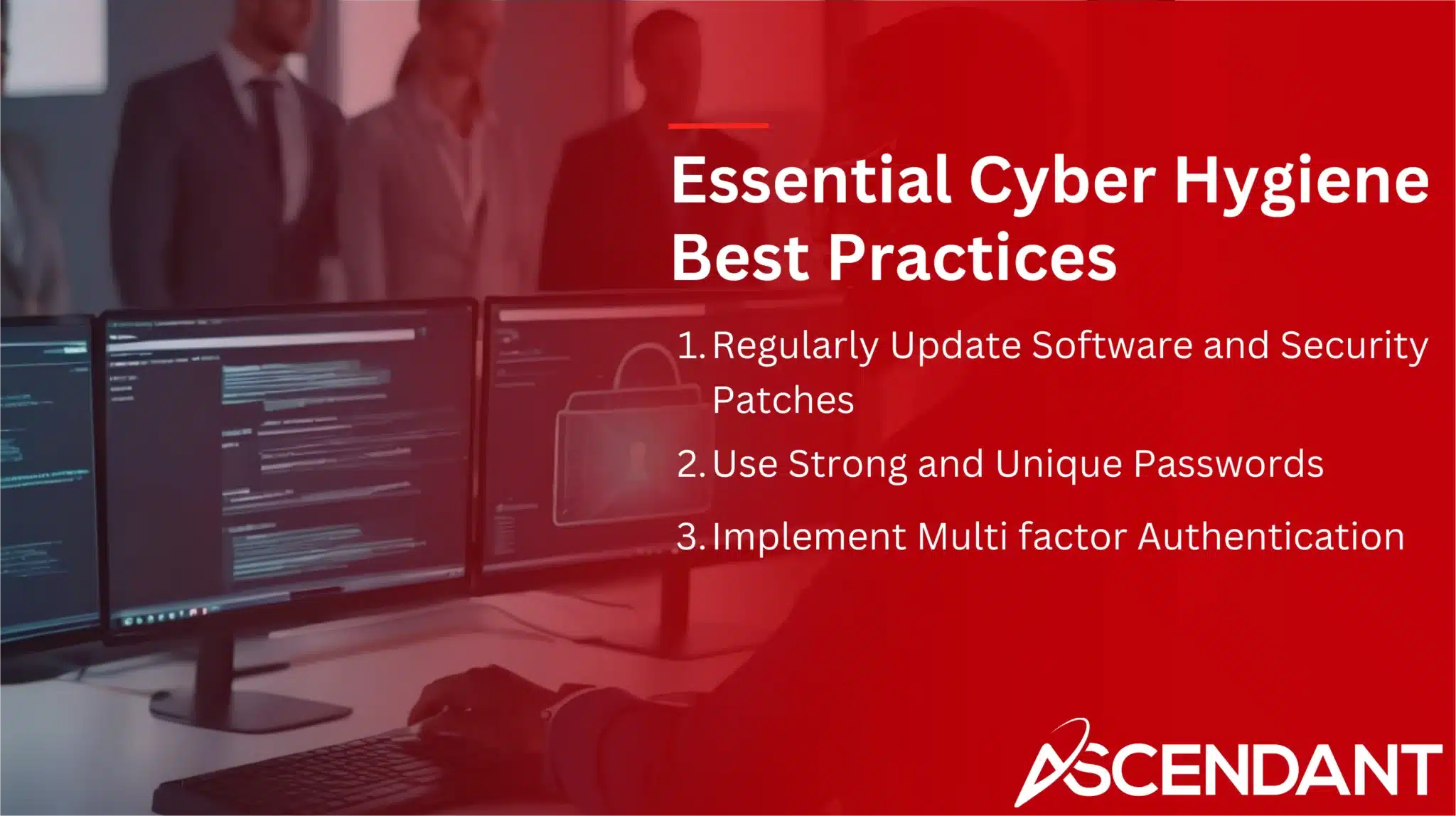Cyber hygiene means maintaining daily practices to protect your digital data from cyber threats like malware and phishing. It’s essential for preventing data breaches. This guide will walk you through key practices such as software updates, strong passwords, and multi-factor authentication.
In This Article:
- Understanding Cyber Hygiene
- Key Benefits of Maintaining Good Cyber Hygiene
- Common Cyber Hygiene Problems to Avoid
- Essential Cyber Hygiene Best Practices
- Creating a Cyber Hygiene Routine
- The Role of Security Awareness Training
- Utilizing Cyber Hygiene Resources
- Measuring Your Cyber Hygiene Effectiveness
Key Takeaways
- Cyber hygiene encompasses practices aimed at protecting digital environments from threats such as data breaches and malware, making it crucial for personal and organizational security.
- Consistent cyber hygiene practices, including software updates, strong passwords, and multi-factor authentication, significantly reduce the risk of cyberattacks and enhance operational integrity.
- Security awareness training and the implementation of a unified cyber hygiene policy are essential for fostering a security-centric culture and effectively managing vulnerabilities within an organization.
Understanding Cyber Hygiene
Cyber hygiene, much like personal hygiene, involves maintaining cyber hygiene to protect your digital environment. It is the practice of ensuring that systems, devices, networks, and data remain secure and healthy through consistent and proper use of technology. The primary goal of cyber hygiene is to keep sensitive information safe from cyber-attacks and theft. A cyber hygiene checklist can help individuals and organizations stay on track with these essential practices.
Good cyber hygiene is essential for safeguarding critical systems and sensitive data from various cyber threats such as hacking, phishing, and malware attacks. Poor cyber hygiene can lead to increased security breaches, putting your data and systems at risk.
Common cyber threats necessitating robust cyber hygiene include identity theft and ransomware attacks, making proper practices non-negotiable.
Key Benefits of Maintaining Good Cyber Hygiene
Adhering to robust cyber hygiene practices yields a wealth of benefits. Foremost, it dramatically minimizes the risk of experiencing data breaches and being targeted by cyberattacks, thus fostering a more secure digital space. These practices serve as crucial barriers against the infiltration of malware and ransomware, helping to keep systems safe from unauthorized access.
Commitment to strong cyber hygiene measures instills greater confidence among staff members and business associates alike by elevating their trust in your commitment to safeguarding sensitive information. This heightened sense of security not only leads to an increase in efficiency, but also decreases stress associated with conducting online activities due to the decreased potential for interruptions.
Maintaining diligent adherence to good cyber hygiene facilitates formidable protection against various forms of digital threats while preserving the integrity essential for uninterrupted business operations.
Common Cyber Hygiene Problems to Avoid
Lax cyber hygiene practices can result in severe outcomes, such as data breaches, financial repercussions, disruptions to operations, tarnished reputations and possibly even the shutdown of a business. The difficulty of maintaining good cyber hygiene is compounded by an ever-changing landscape of cyber threats, human mistakes and complex IT systems.
Merging outdated legacy systems with modern technologies can inadvertently introduce security gaps that are difficult to detect and rectify. Employee errors due to inadequate awareness or training can lead to succumbing to deceptive tactics like social engineering or unintentionally circumventing established security protocols.
Not updating software presents an attractive target for those looking to exploit cybersecurity weaknesses. It underscores the necessity of regularly updating all systems as part of good cyber hygiene measures against potential digital dangers.
Essential Cyber Hygiene Best Practices
It is vital to adhere to the best practices of cyber hygiene in order to sustain a secure digital environment. Keeping software current and promptly installing security patches constitutes a basic yet essential measure for safeguarding data against cyber threats. Strengthen your security by creating strong, unique passwords and integrating multi-factor authentication.
Such measures are integral elements of an effective cybersecurity strategy, providing fundamental protection within the complex landscape of digital security.
Regularly Update Software and Security Patches
Neglecting to update software can create significant vulnerabilities that cybercriminals are eager to exploit. To counter these risks, it is crucial to frequently upgrade your systems with the latest security patches, thereby addressing potential weaknesses and shutting down opportunities for cyber threats.
Nevertheless, prior to rolling out these security updates across your networks, it’s imperative that they undergo thorough testing to circumvent any negative impact on your operations. A robust policy dedicated to cyber hygiene should encompass routine procedures for updating software and incorporate training initiatives so all users comprehend the critical nature of operating with current system versions.
Use Strong and Unique Passwords
Employing strong passwords and steering clear of standard default credentials are critical measures to prevent unauthorized entry. To diminish the likelihood of security breaches, it is essential to consistently update strong, unique passwords across all accounts. Leveraging a password manager aids in this endeavor by creating and preserving intricate passwords that meet these criteria.
Facilitating secure access while managing numerous account logins effortlessly can be achieved through the use of a password manager. It does not sacrifice robustness for convenience when handling your digital keys. This method stands as an integral element in upholding good cyber hygiene practices.
Implement Multi Factor Authentication
Multi-factor authentication (MFA) enhances security by necessitating additional verification beyond a mere password to gain access to an account. This extra step in validation considerably raises the barrier for unauthorized individuals seeking to obtain sensitive data.
To reap the full benefits of MFA, it’s critical that it is set up correctly. Systems can remain susceptible to breaches if MFA is not configured accurately, hence adhering to established best practices during the implementation of this protective mechanism is essential.
Creating a Cyber Hygiene Routine
Maintaining a secure digital environment hinges on the regular practice of good cyber hygiene. Keeping an inventory of all your organization’s hardware and software offers a complete picture of your cybersecurity terrain.
To pinpoint and mitigate possible security vulnerabilities, it is essential to include routine vulnerability scans, data backups, and security audits in your cyber hygiene protocol.
Document All Hardware and Software
Maintaining detailed records of all the hardware, software, and web-based applications utilized by your company provides a thorough inventory of your assets. Such an approach facilitates enhanced monitoring and administration of these resources, guaranteeing that no asset is overlooked.
It’s crucial to securely discard any equipment that is no longer in use by erasing data thoroughly and safeguarding against unauthorized access to such information. Doing so reduces potential security threats and upholds the robustness of your cybersecurity framework.
Identify and Address Vulnerabilities
Ensure that you perform frequent vulnerability assessments to detect and address possible security vulnerabilities in your recorded elements. Maintaining these scans as part of an ongoing commitment towards robust cyber hygiene practices is crucial, so that new threats can be swiftly dealt with.
By correctly discarding equipment that is no longer in use, you reduce the likelihood of security risks. This action helps close down possible gateways for cyber threats, thus strengthening your organization’s overall security stance.
Establish a Unified Cyber Hygiene Policy
Establishing a cohesive policy for cyber hygiene is pivotal in fostering uniformity of procedures within your organization. It should comprise directives that govern the management of new software installations, restrict user access appropriately, and underscore the importance of adhering to good cyber hygiene practices. Ensuring that password updates occur frequently and system checks for upgrades are conducted regularly must be integral aspects stipulated by this policy.
Setting forth explicit expectations concerning cyber hygiene among all users cultivates an environment with enhanced security and resilience against digital threats. Such a consolidated strategy is instrumental in preserving exemplary cyber hygiene habits as well as safeguarding confidential information from potential breaches.
The Role of Security Awareness Training
Training in security awareness fosters a mindset centered on security within the workforce, markedly decreasing the likelihood of mistakes related to cybersecurity due to human oversight. The enhancement of this training is achieved by continuous instruction regarding contemporary cyber threats and best practices for staying safe online. Employing a variety of educational techniques that cater to different ways people learn can increase the success rate of these programs.
Employing phishing simulations bolsters employees’ skills in identifying and reacting appropriately to cyber risks, thereby aiding adherence to legal requirements and professional benchmarks. A well-rounded approach to training staff about security awareness stands as a fundamental pillar for any strong cybersecurity strategy, particularly when considering defense against phishing attacks.
Utilizing Cyber Hygiene Resources
Leveraging the cyber hygiene resources at your disposal can significantly bolster the security protocols within your organization. A robust collection of complimentary cybersecurity services and tools, designed to improve cyber hygiene for a range of entities, is offered by the Cybersecurity and Infrastructure Security Agency (CISA).
Tools from firms such as Bitsight are available to supervise an organization’s cyber hygiene on a continual basis. By taking advantage of these types of resources, companies can reinforce their cybersecurity barriers and reduce their vulnerability to potential online threats.
Measuring Your Cyber Hygiene Effectiveness
Ensuring the efficacy of your cyber hygiene practices is critical for creating a secure digital environment. Utilizing security ratings, for example, Bitsight Security Ratings can enable organizations to evaluate their cybersecurity strength in relation to benchmarks such as NIST. Conducting periodic scans and assessments helps pinpoint potential vulnerabilities and facilitates immediate remediation.
Technical shortcomings within an organization’s security measures are revealed through compliance scans that prompt necessary enhancements. The Cybersecurity Performance Goal (CPG). Assessment provided by CISA assists organizations in determining key priorities within their cybersecurity initiatives. Consistent evaluations and scanning activities form essential elements of a robust cybersecurity program.
Summary
In essence, safeguarding sensitive data and fortifying the security of one’s digital space is contingent on practicing good cyber hygiene. The adoption of robust practices, including consistent software updates, the creation of strong passwords, and the employment of multi-factor authentication, can greatly diminish susceptibility to cyber threats.
Formulating a routine for maintaining good cyber hygiene and making use of accessible tools will bolster your defenses against cybersecurity risks. It’s crucial to embrace a proactive stance when it comes to establishing routines that protect your digital assets and ensure you operate within an environment that’s secure and able to withstand potential breaches.
 Frequently Asked Questions
Frequently Asked Questions
What is cyber hygiene?
Maintaining cyber hygiene is critical in protecting sensitive data and securing systems and networks by adhering to best practices in the use of technology. These habits are vital for the defense of personal as well as organizational information.
Why is maintaining good cyber hygiene important?
Preserving sensitive data and critical systems from cyber threats, including hacking and malware attacks, is crucial. Good cyber hygiene acts as the primary barrier to prevent potential security breaches.
By giving priority to good cyber hygiene practices, one can reinforce the overall digital protection of their systems.
What are some common cyber hygiene problems to avoid?
To avoid cyber hygiene problems, ensure that software is regularly updated, minimize human error through training, and address issues with legacy systems to enhance security.
Prioritizing these practices will significantly reduce the risk of security incidents.
How can I measure the effectiveness of my cyber hygiene practices?
To effectively measure your cyber hygiene practices, utilize security ratings, conduct routine scans and compliance assessments, and consider tools such as Bitsight Security Ratings and CISA’s Cybersecurity Performance Goal Assessment.
These methods will provide valuable insights into the strengths and weaknesses of your current practices.
What resources are available to help improve my cyber hygiene?
To improve your cyber hygiene, utilize resources like CISA’s database of free cybersecurity services and tools, as well as monitoring tools from companies like Bitsight.
These resources provide valuable support in maintaining cybersecurity best practices.


